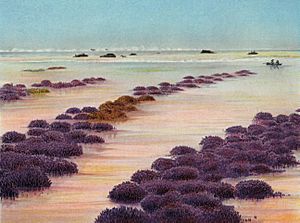List of corals of the Houtman Abrolhos facts for kids

The Houtman Abrolhos is a group of islands located off the coast of Western Australia. These islands are famous for their amazing underwater world, especially their many types of coral. Even though the Abrolhos is quite far south for coral reefs, it has a surprisingly large number of coral species. Scientists have found 194 different kinds of coral here, belonging to 50 different groups (called genera). This article will tell you more about the corals found in the waters around the Houtman Abrolhos.
Contents
Types of Corals in the Abrolhos
Corals are tiny animals that live in colonies and build hard, stony skeletons. These skeletons create the structures we know as coral reefs. There are two main types of corals found in the Houtman Abrolhos: hermatypic corals and ahermatypic corals.
Hermatypic Corals: The Reef Builders
Hermatypic corals are often called "reef-building" corals. These corals have a special partnership with tiny algae called zooxanthellae (pronounced: zoh-oh-zan-THEL-ee). The algae live inside the coral's tissues and use sunlight to make food through photosynthesis. In return, the coral gets energy from the algae, which helps it grow faster and build its hard, stony skeleton. This is why hermatypic corals need clear, shallow water where sunlight can reach them.
In the Houtman Abrolhos, scientists have found 184 different species of hermatypic corals, belonging to 42 different genera. These corals are responsible for creating the beautiful and complex reef structures that provide homes for countless other marine animals. Some common groups of hermatypic corals found here include Acropora (often called staghorn or table corals) and Montipora.
Ahermatypic Corals: The Non-Reef Builders
Ahermatypic corals are different from hermatypic corals because they do not have the special algae living inside them. This means they don't need sunlight to grow. Because of this, ahermatypic corals can live in deeper, darker waters where sunlight doesn't reach. They get all their food by catching tiny particles and plankton from the water.
While they don't build large reefs like their hermatypic cousins, ahermatypic corals are still an important part of the marine ecosystem. The Houtman Abrolhos is home to ten different species of ahermatypic corals, spread across eight genera.
Why So Many Corals at Abrolhos?
It's quite amazing that the Houtman Abrolhos has such a high number of coral species. Usually, places further away from the equator (like the Abrolhos, which is at a higher latitude) have fewer types of corals because the water can be cooler. However, the Abrolhos benefits from warm ocean currents that bring in larvae (baby corals) from other coral-rich areas, helping to keep its coral diversity high. This makes the Abrolhos a very special place for marine life.
See also
 In Spanish: Anexo:Corales de Houtman Abrolhos para niños
In Spanish: Anexo:Corales de Houtman Abrolhos para niños

